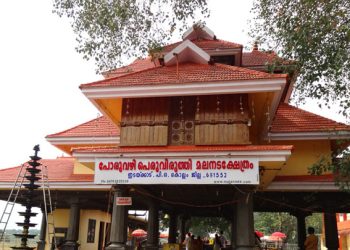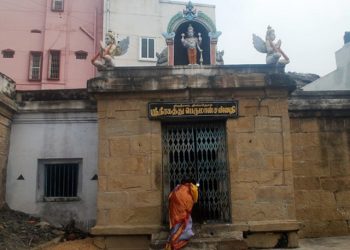Dakshineswar temple is one of the most revered, sacred temples in Kolkata, dedicated to goddess Kali. Dakshineswar Temple is one of the largest temples near Kolkata and it is also an architectural treasure. The temple was built in conventional Nava-Ratna style.
Shrine’s History
The Dakshineswar Kali Temple was founded around the middle of the 19th Century by Rani Rashmoni. Rani Rashmoni was a Mahishya by caste and was well known for her philanthropic activities. In the year 1847, Rashmoni prepared to go on a long pilgrimage to the sacred Hindu city of Kashi to express her devotions to the Divine Mother. Rani was to travel in twenty-four boats, carrying relatives, servants and supplies. According to traditional accounts, the night before the pilgrimage began, Rashmoni had a vision of the Divine Mother, in the form of the goddess Kali in a dream and reportedly said, There is no need to go to Banaras.
Install my statue in a beautiful temple on the banks of the Ganges river and arrange for my worship there. Then I shall manifest myself in the image and accept worship at that place. Profoundly affected by the dream, Rani immediately looked for and purchased a 20-acred plot in the village of Dakshineswar. The large temple complex was built between 1847 and 1855. The 20-acre plot was bought from an Englishman, John Hastie and was then popularly known as Saheban Bagicha, partly old Muslim burial ground shaped like a tortoise, considered befitting for the worship of Shakti according to Tantra traditions, it took eight years and nine hundred thousand rupees to complete the construction, and finally the idol of Goddess Kali was installed on the Snana Yatra day on 31 May 1855, amid festivities at the temple formally known as Sri Jagadishwari Mahakali, with Ramkumar Chattopadhyay as the head priest; soon his younger brother Gadai or Gadadhar later known as Ramakrishna) moved in and so did nephew Hriday to assist him.
On 31 May 1855 more than 1 lakh Brahmins were invited from different parts of the country to grace the auspicious occasion. The next year, Ramkumar Chattopadhyay died, the position was given to Ramakrishna, along with his wife Sarada Devi, who stayed on the south side of the Nahabat (music room), in a small room on the ground floor, which now a shrine dedicated to her. From then until his death 30 years later in 1886, Ramakrishna was responsible for bringing much in the way of both fame and pilgrims to the temple. Rani Rashmoni lived only for five years and nine months after the inauguration of the temple. She seriously fell ill in 1861. Realizing that her death was near she decided to handover the property she purchased in Dinajput as a legacy for the maintenance of the temple to the temple trust. She accomplished her task on 18 February 1861 and died on the next day.

Architectural Relevance of This Shrine
Built in the traditional ‘Nava-Ratna’ or nine spires style of Bengal architecture, the three-storeyed south-facing temple has nine spires distributed in upper two storeys, and stands on a high platform with a flight of stairs, overall it measures 46 feet (14 m) square and rises over 100 feet (30 m) high. The garbha griha (sanctum sanctorum) houses an idol of goddess Kali, known as Bhavataraini, standing on the chest of a lying Shiva, and the two idols are placed on a thousand-petaled lotus made of silver.
Close to the main temple are the row of twelve identical Shiva temples built facing the east in the typical aat-chala Bengal architecture, they are built on either side of the ghat on the Hoogly river. To the Northeast of the Temple Complex is the Vishnu Temple or the Radha Kantas Temple. A flight of steps lead to the columned verandah and into the temple where a silver throne rests with a 21 1⁄2-inch (550 mm) idol of Lord Krishna and a 16-inch 410 mm) idol of Radha
Shrine’s Map Location and How to Go There
By Road
The temple is accessed via road or river. For a special treat, one can rent a boat and arrive at the temple’s bathing ghat. It is here Sri Sarada Devi, Sri Ramakrishna’s wife used to bathe. A parking facility is within the temple compound which charges a nominal fee. The Barrackur Road is the major link road to the region. One can get Interstate and many private buses to this temple. The railways in one more option open to reach the place.
By Rail
Nearest Railway Station Dakshineswar (suburban) & Howrah (Junction). Nearest Metro Station Dum Dum.
By Air
Nearest International Airport Netaji Subhas Chandra Bose International Airport.
Shrine Timings
From October to March: 6:00 a.m to 12.30 p.m and 3:00 p.m to 8:30 pm From April to September: 6:00 a.m to 12.30 p.m and 3:30 p.m to 9:00 pm
Events Celebrated at This Shrine
Navaratri,Diwali
Extra Information About this Shrine
Tuesdays and Saturdays are believed as the auspicious day for Kali worship. On both these days, there is a huge congregation of devotees at the Dakshineswar temple. The Sandhya Aarti is the prime attraction of devotees, which is truly amazing.
Temples of Shiva ? The premise of the Dakshineswar temple is admired with twelve identical temples of Shiva. The temples have been erected just opposite to the Kuthi Bari and they nestle close to the banks of River Ganges. The interiors of the Shiva temples are adorned with white and black stone. Each of the temples houses beautiful Shiva Lingas, done in black stone. All these Shiva temples are east facing and they have been erected following the typical Aat Chala Bengal architecture. The series of the Shiva temples are divided by Chadni . Six temples rest at the right of the bank, whereas the other six to the right.
Vishnu Temple ? At the northeast side of the Dakshineswar temple complex, lies the Vishnu Temple or the Radha Kantas Temple. A flight of stairs will lead you inside the temple. The temple houses a 21 and a half inches idol of Lord Krishna and 16 inches idol of Radha. It is said that Sri Ramakrishna himself used to perform puja at this temple. The Panchavati garden, a congregation of five ancient trees, located in close proximity to the Dakshineswar Temple is nicely landscaped and is well maintained by the temple committee. It is said that Sri Ramakrishna used to meditate at this very site.













































